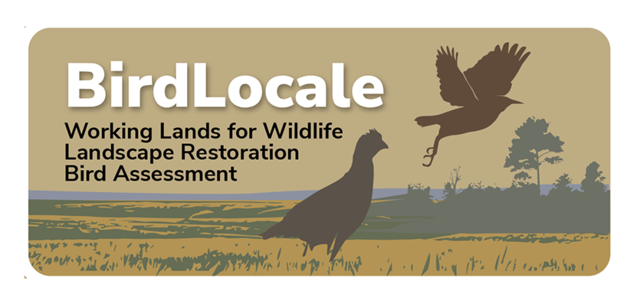-
Working Lands for Wildlife Partner Workspace
-
by
Tab Manager
—
published
Jul 20, 2020
—
last modified
Mar 04, 2025 05:55 PM
—
filed under:
Working Lands for Wildlife,
WLFW
Private workspace for WLFW partners.
Located in
LP Members
/
Workspaces
-
Working Lands for Wildlife (WLFW) Workspace and Species Initiatives Course Series
-
by
Tab Manager
—
published
Apr 11, 2023
This workspace hosts courses for National Resources Conservation Services (NRCS), partners, and private landowners within the WLFW initiatives.
Located in
Training
-
Working Lands for Wildlife (WLFW) Workspace and Species Initiatives Course Series
-
by
Tab Manager
—
published
Apr 16, 2023
This workspace hosts courses for National Resources Conservation Services (NRCS), partners, and private landowners within the WLFW initiatives.
Located in
Training
-
Working Lands for Wildlife (WLFW) Workspace and Species Initiatives Course Series
-
by
Tab Manager
—
published
Apr 16, 2023
This workspace hosts courses for National Resources Conservation Services (NRCS), partners, and private landowners within the WLFW initiatives.
Located in
Training
-
Working Lands for Wildlife (WLFW) Workspace and Species Initiatives Course Series
-
by
Tab Manager
—
published
Apr 16, 2023
This workspace hosts courses for National Resources Conservation Services (NRCS), partners, and private landowners within the WLFW initiatives.
Located in
Training
-
Workspaces
-
by
Tab Manager
—
published
Dec 30, 2020
—
last modified
Aug 11, 2022 11:41 PM
The Work Space area offers a platform to enhance work flow and facilitate efficient sharing of ideas, draft documents, datasets, products, publications, and more with others who have similar interests or missions. If you wish to participate in active discussions and information sharing, you can join one or more Workgroup(s) by contacting Rose Hessmiller rhessmiller@fergusonlynch.com Materials within each Workgroup are private and shared only with co-members but may be made publically availalbe or uploaded to the Resources portion of the Portal.
Located in
LP Members
-
World of Wildland Fire
-
by
Tab Manager
—
published
Apr 09, 2021
—
last modified
Apr 18, 2024 01:24 PM
—
filed under:
Wildland Fire,
WLFW,
Training,
World of Wildland Fire,
Online Training
World of Wildland Fire includes a variety of online courses for fire science educators, trainers, and the public on topics including fire behavior, fuels, and fire ecology.
Located in
Training
/
Online Training Programs and Materials
-
World of Wildland Fire YouTube Channel
-
by
Tab Manager
—
published
Apr 09, 2021
—
last modified
Apr 18, 2024 01:23 PM
—
filed under:
Wildland Fire,
WLFW,
Training,
World of Wildland Fire,
Online Training
The World of Wildland Fire YouTube channel includes videos on fuels, fire behavior, and fire ecology.
Located in
Training
/
Online Training Programs and Materials
-
Yazoo Darter
-
by
Tab Manager
—
published
Dec 05, 2024
—
last modified
Jun 03, 2025 01:25 PM
The Yazoo darter (Etheostoma raneyi) is a small fish that is found only in two watersheds – the Little Tallahatchie and Yocona River watersheds in northern Mississippi. In recent years, Yazoo darter populations have been on the decline, largely because of poor stream health and barriers in streams. To help reverse population declines, NRCS is working with private landowners in targeted areas to increase available habitat and improve water quality to support the species’ recovery.
Located in
Wildlife
-
Yazoo Darter
-
by
Tab Manager
—
published
Feb 15, 2023
The Yazoo darter (Etheostoma raneyi) is a small fish that is found only in two watersheds – the Little Tallahatchie and Yocona River watersheds in northern Mississippi.
Located in
Landscapes & Wildlife
/
Wildlife


